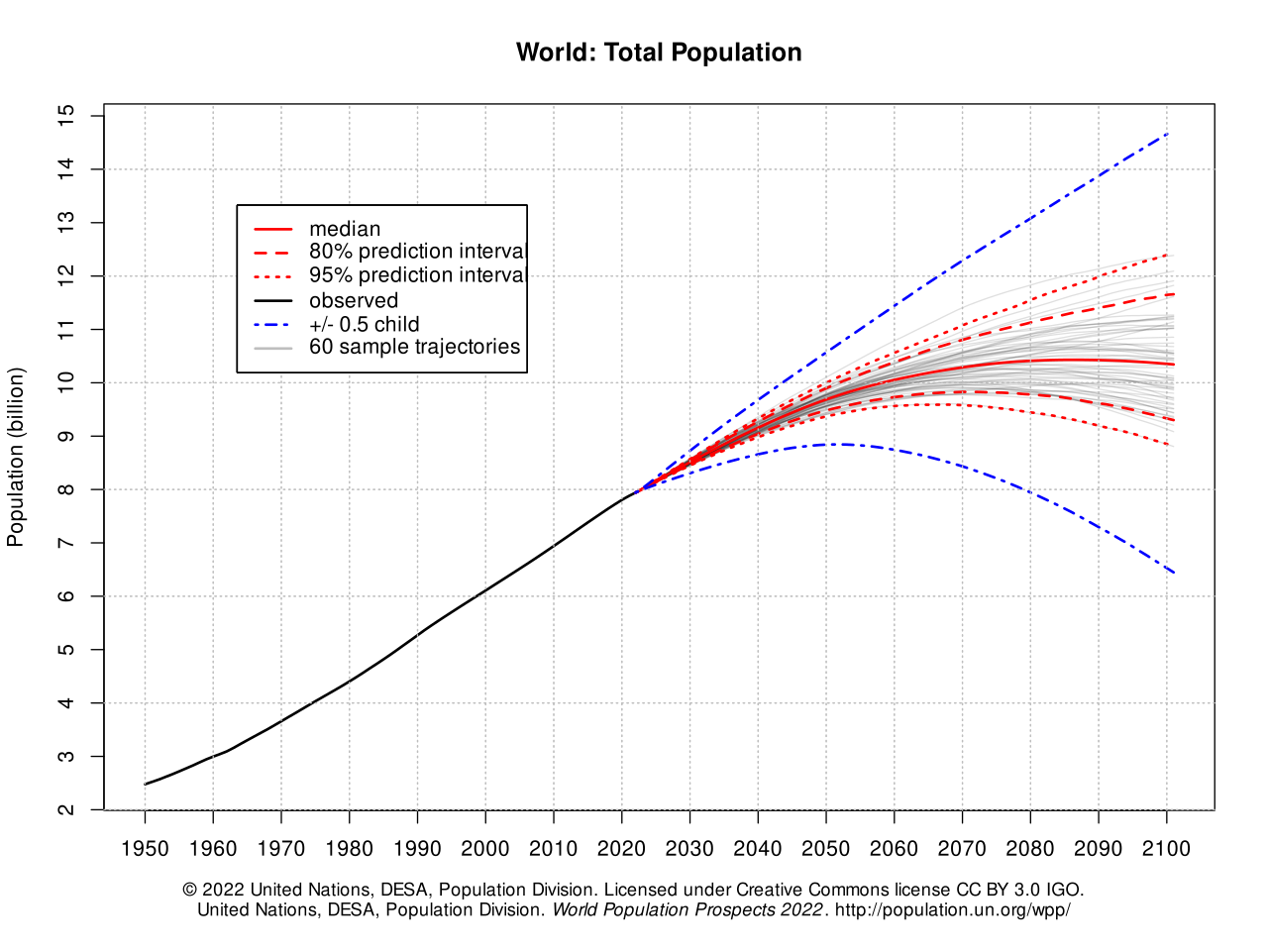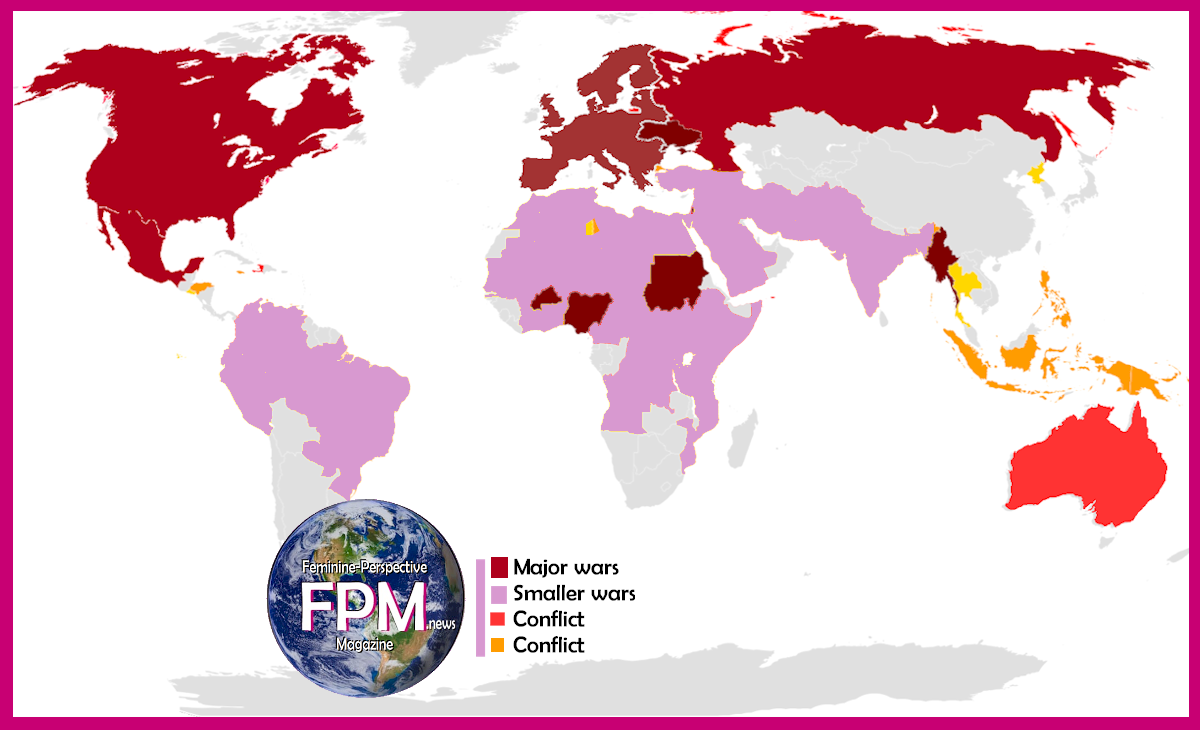Forward by Editor Micheal John
Fertility rates among humans need to be adjusted by various means including migration. The human species on Earth requires a number of babies equal to the human replacement value as the global human population heads to a point where Earth cannot sustain the species with sufficient food, water, and clean air to breathe.
This graph shows estimates and logical probability projections of the total population for the world. The population projections are based on probability projections of total fertility and life expectancy at birth. These projections of total fertility and life expectancy at birth were carried out with a Bayesian Hierarchical Model. The figures display the probabilistic median, and the 80 and 95 per cent prediction intervals of the probabilistic population projections, as well as the (deterministic) high and low variant (+/- 0.5 child).
*Graph by United Nations, DESA, Population Division – , CC BY 3.0 igo
It is estimated by some scientists that somewhere between nine and ten billion people is all the Earth can support with food and water. That applies only when and if humans become vegan and turn all irrigable land into producing food for humans and none for cattle and poultry.
RINJ Women have studied this issue for family planning, reproductive rights, contraceptives counseling, and shape regional family planning and birthing counsel in each region according to local indications of nutrition, human development, TFR, culture and other factors.
The target TFR (Total Fertility Rate) should be at or below 2.1 offspring per family which is the human replacement rate including a factor for infant mortality (which needs to be lowered).
But while poorer and more populace countries are far above the ideal TFR, smaller, richer countries are far below 2.1 TFR. Without a doubt, many in that latter category are too far below the ideal TFR and their economies and their world leadership roles will tank under current migration laws and attitudes. That may pose a significant threat to humanity. The antithesis to this concern is seen in what China has accomplished in four decades by raising the quality of life for hundreds of millions of Chinese. Africa and the rest of Asia needs to do the same, and South America must continue its current path raising education levels and improving human development and the quality of life. Also, greater care is needed across the planet for the very young and the very old.
(Forward by Editor Micheal John)
South Korean economy will suffer as the nation’s population becomes the oldest on Earth.

An aging population, a tired economy. Anthony Wallace/AFP via Getty Images
“South Korean economy threatened by low fertility rate” by Dudley L. Poston Jr., Texas A&M University
Around the world, nations are looking at the prospect of shrinking, aging populations – but none more so than South Korea.
Over the last 60 years, South Korea has undergone the most rapid fertility decline in recorded human history. In 1960, the nation’s total fertility rate – the number of children, on average, that a woman has during her reproductive years – stood at just under six children per woman. In 2022, that figure was 0.78. South Korea is the only country in the world to register a fertility rate of less than one child per woman, although others – Ukraine, China and Spain – are close.
As a demographer who over the past four decades has conducted extensive research on Asian populations, I know that this prolonged and steep decline will have huge impacts on South Korea. It may slow down economic growth, contributing to a shift that will see the country end up less rich and with a smaller population.
Older, poorer, more dependent
Countries need a total fertility rate of 2.1 children per woman to replace their population, when the effects of immigration and emigration aren’t considered. And South Korea’s fertility rate has been consistently below that number since 1984, when it dropped to 1.93, from 2.17 the year before.
What makes the South Korean fertility rate decline more astonishing is the relatively short period in which it has occurred.
Back in 1800, the U.S. total fertility rate was well over 6.0. But it took the U.S. around 170 years to consistently drop below the replacement level. Moreover, in the little over 60 years in which South Korea’s fertility rate fell from 6.0 to 0.8, the U.S. saw a more gradual decline from 3.0 to 1.7.
Fertility decline can have a positive effect in certain circumstances, via something demographers refer to as “the demographic dividend.” This dividend refers to accelerated increases in a country’s economy that follow a decline in birth rates and subsequent changes in its age composition that result in more working-age people and fewer dependent young children and elderly people.
And that is what happened in South Korea – a decline in fertility helped convert South Korea from a very poor country to a very rich one.
Behind the economic miracle
South Korea’s fertility decline began in the early 1960s when the government adopted an economic planning program and a population and family planning program.
By that time, South Korea was languishing, having seen its economy and society destroyed by the Korean War of 1950 to 1953. Indeed by the late-1950s, South Korea was one of the poorest countries in the world. In 1961, its annual per capita income was only about US$82.
But dramatic increases in economic growth began in 1962, when the South Korean government introduced a five-year economic development plan.
Crucially, the government also introduced a population planning program in a bid to bring down the nation’s fertility rate. This included a goal of getting 45% of married couples to use contraception – until then, very few Koreans used contraception.
This further contributed to the fertility reduction, as many couples realized that having fewer children would often lead to improvements in family living standards.
Both the economic and family planning programs were instrumental in moving South Korea from one with a high fertility rate to one with a low fertility rate.
As a result, the country’s dependent population – the young and the elderly – grew smaller in relation to its working-age population.
The demographic change kick-started economic growth that continued well into the mid-1990s. Increases in productivity, combined with an increasing labor force and a gradual reduction of unemployment, produced average annual growth rates in gross domestic product of between 6% and 10% for many years.
South Korea today is one of the richest countries
in the world with a per capita income of $35,000.
Losing people every year
Much of this transformation of South Korea from a poor country to a rich country has been due to the demographic dividend realized during the country’s fertility decline. But the demographic dividend only works in the short term. Long-term fertility declines are often disastrous for a nation’s economy.
With an extremely low fertility rate of 0.78, South Korea is losing population each year and experiencing more deaths than births. The once-vibrant nation is on the way to becoming a country with lots of elderly people and fewer workers.
The Korean Statistical Office reported recently that the country lost population in the past three years: It was down by 32,611 people in 2020, 57,118 in 2021 and 123,800 in 2022.
If this trend continues, and if the country doesn’t welcome millions of immigrants, South Korea’s present population of 51 million will drop to under 38 million in the next four or five decades.
And a growing proportion of the society will be over the age of 65.
South Korea’s population aged 65 and over comprised under 7% of the population in 2000. Today, nearly 17% of South Koreans are older people.
The older people population is projected to be 20% of the country by 2025 and could reach an unprecedented and astoundingly high 46% in 2067. South Korea’s working-age population will then be smaller in size than its population of people over the age of 65.
In a bid to avert a demographic nightmare, the South Korean government is providing financial incentives for couples to have children and is boosting the monthly allowance already in place for parents. President Yoon Suk Yeol has also established a new government team to establish policies to increase the birth rate.
But to date, programs to increase the low fertility rate have had little effect. Since 2006, the South Korean government has already spent over $200 billion in programs to increase the birth rate, with virtually no impact.
Opening the trapdoor
The South Korean fertility rate has not increased in the past 16 years. Rather, it has continued to decrease. This is due to what demographers refer to as the “low-fertility trap.” The principle, set forth by demographers in the early 2000s, states that once a country’s fertility rate drops below 1.5 or 1.4, it is difficult – if not impossible – to increase it significantly.
South Korea, along with many other countries – including France, Australia and Russia – have developed policies to encourage fertility rate increases, but with little to no success.
The only real way for South Korea to turn this around would be to rely heavily on immigration.
Migrants are typically young and productive and usually have more children than the native-born population. But South Korea has a very restrictive immigration policy with no path for immigrants to become citizens or permanent residents unless they marry South Koreans.
Indeed, the foreign-born population in 2022 was just over 1.6 million, which is around 3.1% of the population. In contrast, the U.S. has always relied on immigration to bolster its working population, with foreign-born residents now comprising over 14% of the population.
For immigration to offset South Korea’s declining fertility rate, the number of foreign workers would likely need to rise almost tenfold.
Without that, South Korea’s demographic destiny will have the nation continuing to lose population every year and becoming one of the oldest – if not the oldest – country in the world.![]()
By Dudley L. Poston Jr., Texas A&M University
This article is republished in part from The Conversation under a Creative Commons license.
Notwithstanding your reproductive rights, for safety reasons, RINJ Women urge women in areas of armed conflict to avoid pregnancy. Always use some form of contraception. Extremely high mortality among infants and maternal mortality rates plus heightened incidence of rape in war zones drive The RINJ Foundation Women to share this generalized advice. Much more than half the women die under these circumstances. Almost the same number of babies die. Use good judgment. Use a contraceptive. Get to safety. Then plan your family.
RINJ Women Declare Reproductive Rights of all Families.
- Despite obvious conflicts with spiritual leaders, reproductive rights belong to families who must have the unfettered ability to choose freely and responsibly if and when to have children.
- Close examination of mass deaths in the world in places like Afghanistan, Syria, Yemen, Ukraine, Sudan, Ethiopia, and more, suggests governments are doing an awful job of protecting children and their families.
- It is completely disingenuous for violent men to be arguing that abortion is violence toward children. Notwithstanding that observation the RINJ Foundation suggests that an abuse of induced abortion or abuse of any medical procedure bringing harm to a person could constitute a serious crime. All life is precious. ‘Don’t use abortion as a method of birth control’, is RINJ Women’s warning, worth repeating. Use contraception.
- Families must have easy access to valid and safe contraceptives as well as safe and validated health care for them and their children.
- The global maternal death rate at childbirth is horrifying. The same is true of infant mortality. Children born into severe poverty are not surviving. The alleviation of this problem lies partly in the global goals of human development. Family planning is one of the tools for poverty’s mitigation and elimination. In the Philippines, a third of all children under five are stunted. This is a wake-up call to a global problem.
- Maintaining a Total Fertility Rate (TFR) of 2.1 is a valid goal for family planning educators. Earth has limits on what number of human occupants it can support. Approaching 9 billion world population the TFR must maintain somewhere around 2.1 barring any catastrophic events.
- Family planning and reproductive rights belong to each and every family. Governments must be asked to provide free of charge, safe, modern contraceptives.














